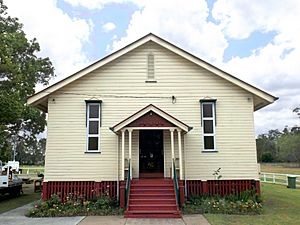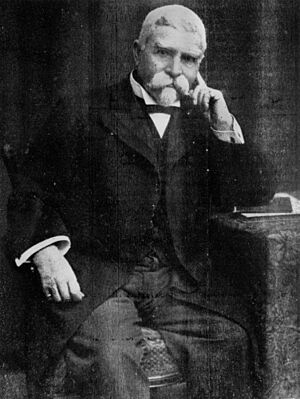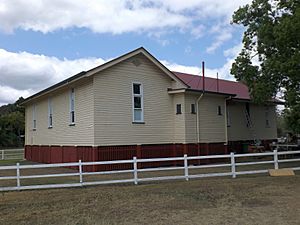United Welsh Church, Blackstone facts for kids
Quick facts for kids United Welsh Church, Blackstone |
|
|---|---|

Front of the building, 2015
|
|
| Location | 6 Thomas Street, Blackstone, City of Ipswich, Queensland, Australia |
| Design period | 1870s - 1890s (late 19th century) |
| Built | 1886 |
| Architect | Samuel Shenton |
| Official name: United Welsh Church, Blackstone, Welsh Chapel, Welsh Union Church | |
| Type | state heritage (built) |
| Designated | 21 October 1992 |
| Reference no. | 600548 |
| Significant period | 1886 (fabric) |
| Significant components | trees/plantings, memorial - honour board/ roll of honour, furniture/fittings, memorial - rock/stone/boulder, memorial - plaque |
| Builders | Worley & Whitehead |
| Lua error in Module:Location_map at line 420: attempt to index field 'wikibase' (a nil value). | |
The United Welsh Church is a special old church located in Blackstone, Queensland, Australia. It's known as a heritage site, meaning it's important to history. The church was designed by an architect named Samuel Shenton and built in 1886 by Worley & Whitehead. People also call it the Welsh Chapel or Welsh Union Church. It was added to the Queensland Heritage Register on October 21, 1992, to protect its historical value.
Contents
A Look Back: The Church's Story
The United Welsh Church was built in 1886. It was designed by Samuel Shenton, an architect and builder from Ipswich. The construction was done by Worley and Whitehead, who were also contractors from Ipswich.
The land for the church was given by Lewis Thomas. He owned coal mines in the area and also helped pay for the church to be built.
Welsh Settlers in Blackstone
Lewis Thomas started mining coal in Blackstone in the 1860s. In 1883, a group of Welsh people came to Blackstone. They used to be slate miners from a place called Blaenau Ffestiniog in Wales. They came to Australia to work for Lewis Thomas in his coal mines.
Soon after they arrived, these Welsh settlers held a Protestant church service. They met under a mulberry tree near Bundamba Creek. They decided that their shared Welsh nationality was more important than small differences in their church beliefs. So, they formed a Welsh union church, where different groups could worship together.
The first combined service was held on July 19, 1883, in a church hall in a nearby area called Newtown. Lewis Thomas then let them use a small house in Blackstone for their services. As more Welsh immigrants arrived, this house became too small. That's when Lewis Thomas donated the land for a proper church building.
The new church officially opened on October 16, 1886. The opening was celebrated with a tea-meeting and a concert.
Changes Over Time
Old photos of the church show that its outside walls had exposed wooden frames. Now, the walls are covered with a type of timber called chamferboard. No one knows exactly when this change happened, but it was done by the 1930s.
In 1892, the church was painted, and new seats were made. This work was overseen by architect George Brockwell Gill. He had taken over Samuel Shenton's business. Toilets were added on the northern side of the church around 1975. The front windows, which used to have louvres (slats), were later replaced with glass.
The church has faced floods. In 1893, a big flood reached the top windows, destroying the organ and early church records. In 1974, another flood reached a few centimetres above the floor.
Special Items and Memories
Inside the church, you can see many old photos, memorials, and special items. These are displayed in the main part of the church and in the back meeting room.
- A war memorial board was put up in 1917 to remember those who served.
- A plaque was added in 1986 to celebrate 100 years of the Cambrian Choir.
- After Lewis Thomas's large house, called Brynhyfryd, was taken down in the 1930s, some items from it were moved to the church. These include a pair of glass and cedar doors with "Brynhyfryd" etched into the glass. They were installed as a screen inside the church entry.
- A cedar fireplace surround from the mansion was turned into a memorial. It honors both Welsh pioneers and those who served in World War II.
- Around 1985, the St David Society gave the church Leadlight windows. These beautiful windows show Welsh dragons, a symbol of Wales.
Community and Culture
In its early years, the church was called the Welsh Union Church. By the early 1900s, it was known as the United Welsh Church. For many years, the church had a full-time minister. Now, a part-time minister leads a weekly service.
The church has always been a lively place for the community. It has hosted many social events like church teas, clubs, and music festivals. In the early days, church services were held in Welsh. Today, some hymns are still sung in a mix of Welsh and English. Children in Sunday School even learn a few Welsh words.
The first Gymanfa Ganu (a Welsh hymn festival) was held here in 1902. This special event is still held every two years.
The Eisteddfod Tradition
An eisteddfod is a traditional Welsh competition for music, writing, and speaking. The first eisteddfod at the church was held on New Year's Day in 1887, just a few months after the church opened. A local choir was formed to compete in this event. This choir is still active today and is known as the Blackstone-Ipswich Cambrian Choir.
As more people became interested, later eisteddfodau were held either at the church or at the Ipswich School of Arts. In 1888, a choir from Brisbane joined the competition. This led to a Brisbane eisteddfod in 1889. These competitions between cities eventually grew into the Queensland Eisteddfod. This big event is still held every Easter. Smaller eisteddfodau, like a junior one and a Silkstone Eisteddfod, are still held every year in Ipswich.
The United Welsh Church is the only Welsh Church in Queensland. It is believed there are only three other Welsh churches in Australia: one in Sydney, one in Melbourne, and one in Western Australia.
What the Church Looks Like
This church is a simple timber building. It has a rectangular main hall, called a nave, and a special area at the front, called a sanctuary. At the back, there's a room called a vestry, which forms a "T" shape with the main building. A modern toilet block with a skillion roof is built on the northern side.
The walls are made of timber frames and are now covered with chamferboard. The wooden floor is supported by concrete stumps. The roof is a gently sloped gable roof, covered with corrugated galvanised iron.
At the front, there's an entrance porch with its own gable roof. It has a pretty, decorative wooden design called fretwork above the entrance. Above the porch, there's a fixed timber window with a pointed top, used for ventilation. The railing on the front steps is made of wrought iron.
The side windows of the church are timber casements that pivot open. The front windows have unusual decorative timber hoods on the outside.
Inside the Church
The inside of the church has some beautiful cedar woodwork in the sanctuary area. The church also has special furniture for services, like a silky oak minister's chair. The wooden pews (church benches) have decorative ends with numbers on them.
Above the doors in the back wall, which lead to the vestry/meeting room, are two leadlight windows. These windows feature the Welsh dragon. The walls inside display several wooden plaques and memorials.
A continuous open-fretwork ventilator runs along the entire length of the nave walls, just below where the roof begins. The ceiling is boarded, and the roof is supported by iron tie-rod trusses.
The rear vestry/meeting room is a large rectangular space. Its walls are decorated with framed photographs and other items that hold special memories.
The Church Grounds
The church grounds have a very large camphor laurel tree on the northern side. There are also two rock monuments. One has a plaque celebrating the church's centenary (100 years). The other has a piece of rock from the site of the old "Brynhyfryd" mansion.
Why This Place is Special
The United Welsh Church in Blackstone was added to the Queensland Heritage Register on October 21, 1992. This means it meets certain important standards.
Showing Queensland's History
The church, built in 1886, helps us understand Queensland's history. It shows how Welsh families came to coal mining areas in Queensland in the 1880s. It also shows how they brought Welsh traditions, like the Eisteddfod, which are still part of Queensland's culture today.
A Rare Find
This church is the only Welsh Church in Queensland. It is thought to be one of only four in all of Australia, making it quite rare.
Learning from the Past
The inside of the church has old photos, memorials, and special items. These things help us learn about Welsh customs and culture that have been kept alive in Australia.
A Landmark Building
The simple, traditional look of the church and the large camphor laurel tree next to it make it a recognizable landmark. It stands out near Bundamba Creek as you approach the Blackstone area.
Beautiful and Important
The church's simple, traditional design and the large camphor laurel tree give it a special beauty. They make it a notable landmark near Bundamba Creek as you enter Blackstone.
Important to the Community
The church has been a place for church services, social events, and eisteddfodau. Because of this, it has a strong connection to the social, cultural, and spiritual life of Blackstone and the wider Queensland community since 1886.
Notable People
- T. Rees Thomas, a minister, attended this church when he was young.




